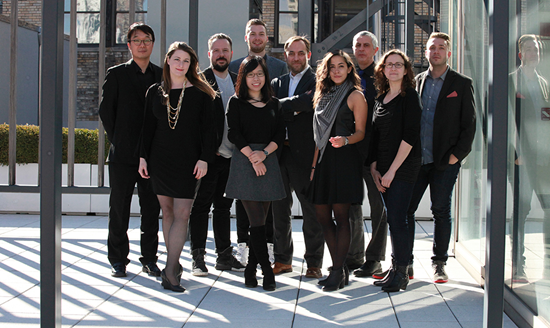& Construction

Integrated BIM tools, including Revit, AutoCAD, and Civil 3D
& Manufacturing

Professional CAD/CAM tools built on Inventor and AutoCAD
4 min read
How do you infuse iconic houseware brands with fresh style? By investing heavily in innovation, cross-pollinating the talents of your team, and finding the right tools to free up your designers’ creativity. That’s what bathroom-fixture titan American Standard and its parent company LIXIL are doing with their new design center in New York City—and by using Fusion 360.

Many consumers aren’t familiar with LIXIL, a top player in construction materials formed by the merger of five Japanese businesses. Over the past decade, it has expanded beyond Japan by acquiring American Standard in Asia and the U.S. and GROHE in Germany, as well as the luxury brand DXV. Many people associate American Standard with sinks and toilets, but the LIXIL portfolio covers all categories of kitchen and bathroom fittings and fixtures, from ceramics to brassware.
LIXIL has also put a big emphasis on design. Jean-Jacques L’Henaff, VP of design at LIXIL Americas, points out that the industry has spent 150 years making its goods the same way, “melting and casting metal to make faucets, or firing clay to make toilets.” LIXIL is shaking that up with its innovative designs, including the ActiClean self-cleaning toilet and the remote-operated Spectra Touch showerhead.

L’Henaff’s team continually develops new product designs that are brought to the market during “launch windows” every April, July, and November. He laughs when he adds that “sometimes the timeline is reduced quite dramatically,” especially to meet the needs of large retailers. For example, when a certain home-improvement giant needs a new product on the shelf in September, LIXIL must have it in the warehouse by the end of July. “It’s an incredibly tight production cycle,” L’Henaff says.
Members of the global design team are spread across design centers in New York, Tokyo, Düsseldorf, and Bangkok. Individuals spend most of their time on specific product categories and for specific brands. For example, Greg Reinecker has spent the past year working mostly on showerheads and valves for American Standard and DXV, while Jacob Nitz has focused on GROHE faucets.
The team also sometimes bridges categories to bring different design concepts and aesthetics to the work. As Reinecker puts it, “When you do something collaborative, you get these [creative] facets from each different group or segment.”
 The designers have found that Fusion 360 gives them more flexibility and speed during the design process. Reinecker says he now has more freedom: “Generally, I was using ProE before. I think with Fusion 360, there’s just more of a free-flow aspect to it, where you’re thinking less about the tool, and more about what you’re designing.”
The designers have found that Fusion 360 gives them more flexibility and speed during the design process. Reinecker says he now has more freedom: “Generally, I was using ProE before. I think with Fusion 360, there’s just more of a free-flow aspect to it, where you’re thinking less about the tool, and more about what you’re designing.”
As he puts it, using Fusion 360 brought the CAD experience back to the designer’s side, rather than the engineering side. After sketching out ideas by hand or digitally with Autodesk SketchBook, he will get right into Fusion 360 to bring those sketches to life. Whereas previously his designs were driven more by parametric numbers, now he can “create designs without feeling so constrained.”
For his part, Nitz says, “I probably get into CAD a little quicker than most designers. I’ll do some quick sketches, and then I like to get into it.” He was an early adopter of T-splines in Rhino, and was used to working in that application alongside Solidworks. Fusion 360’s combination of parametric design and T-splines for sculpting has streamlined his workflow nicely.
“I would say it’s definitely sped up my ideation process,” he says.
L’Henaff adds that “I don’t think people realize how complex and how sculptural a faucet can be.” It’s also a very technical product, so “it’s not an easy product to design.” From his perspective, good design at LIXIL is “really a balance between right brain and left brain.” Fusion 360 addresses all of those complexities. “It’s really making a big difference,” L’Henaff says.
The team is looking forward to using Fusion 360 to design products that will be 3D-printed in metal, a technology whose costs are coming down. Reinecker, for instance, is using the software to develop the “very organic form” of hand showers. ”A lot of our products are chrome,” he adds, “and when you chrome something, you can see every little detail.” Any flaws in the design will be magnified in the manufacturing stage.
Keeping that reality in mind, L’Henaff says that his goal is to preserve the team’s beautiful designs, rather than having them adapted—and potentially diminished—to meet engineering needs. To achieve that, he puts a premium on tools that “allow creativity to flourish and make that transition to engineering.”
He adds: “That’s what Fusion 360 is helping us do today.”
By clicking subscribe, I agree to receive the Fusion newsletter and acknowledge the Autodesk Privacy Statement.
Success!
May we collect and use your data?
Learn more about the Third Party Services we use and our Privacy Statement.May we collect and use your data to tailor your experience?
Explore the benefits of a customized experience by managing your privacy settings for this site or visit our Privacy Statement to learn more about your options.